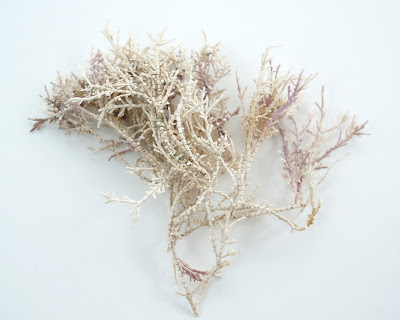What did I find? More cigarette butts than I've ever seen on a beach. Hello smokers? The world is not your ashtray. I try to pick up trash when I comb, but cigarette butts, bandaids, stuff like that grosses me out and I won't touch it. Plenty of non-personal trash, like soda bottles, plastic food wrappers, bits of rope. Lots of crab shells, some periwinkle shells, a whole lot of seaweed. And an unusual amount of coralline.
Let me tell you about coralline, because I'm just learning about it myself. See that delicate white frondy thing in the second row from the top, far left? Here it is a little closer:
And a little closer:
So I'm a little obsessed with my macro setting! Anyway, Common Coralline (Corallina officinalis) is an algae impregnated with calcium carbonate (the building block of limestone), which is why it feels like stone, or coral. Around here it is bright (and I do mean bright) pink underwater, but when it dries out it slowly turns white. You can see hints of pink in the photos above. That is not bad photo editing!
There are two kinds of coralline that I see on my local beachs. Most often it is a thick crust on crab shells and rocks. This is the more plant-like form. Don't those segmented stems look like spinal columns? I find I look at it differently now that I know what it is.
Two very useful guides that taught me about coralline:
Hausman, Leon, The Beginner's Guide to Seashore Life
Shumway, Scott W., The Naturalist's Guide to the Atlantic Seashore




No comments:
Post a Comment